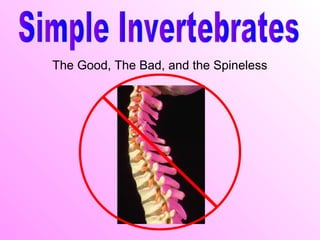
Simple invertebrates
- 1. The Good, The Bad, and the Spineless
- 2. Invertebrate Characteristics • They are all very different from each other • Examples: jellyfish, clams, earthworms, grasshoppers • Have 3 different basic body plans, or types of symmetry • Can be bilateral, radial, or asymmetry (no symmetry at all)
- 3. Bilateral: the two sides of its body mirror each other. Radial: Its body is organized around the center, like spokes on a Asymmetrical: cannot wheel draw a straight line to divide its body into two or more equal parts. Its body is not organized around a center.
- 4. Neurons and Ganglia • All animals except sponges have special tissues that make fibers called neurons, which allow animals to sense their environment • Neurons also carry messages around the body to control animal’s actions • Simple invertebrates have neurons arranged into a nerve cord • In some, many nerve cells come together as ganglia
- 5. • Each ganglion controls different parts of the body •Ganglia are controlled by the brain
- 6. • Gut: pouch lined with cells that release chemicals that break down food into small particles • In complex animals, gut is inside a coelom • Coelom: body cavity that surrounds the gut and contains many organs, such as the heart and lungs (but kept separate) • Keeps gut movement from disturbing other body processes
- 8. • Sponges cannot move and do not have gut • A sponge sweeps water into its body through its pores • Water flows into cavity in the middle of the body, bringing oxygen and food • Special cells called collar cells line the cavity and filter and digest food
- 9. • Water leaves the body through a hole in the top of the sponge called the osculum • Sponges have unusual abilities—if you force it through a strainer, the parts come back together and reform a sponge —called regeneration.
- 10. • A sponge’s skeleton supports its body and helps protect it from predators • Most sponges have skeleton made of small, hard fibers called spicules – Some are straight, curved, or have complex star shapes • Sponges are divided into groups based on kind of skeleton it has
- 11. • Cnidarians – Invertebrates with stinging cells – Just like sponges, if the body cells are separated, they can come back together to re-form the cnidarian – Two body forms • Medusa: swim through water • Polyps: usually attach to surface
- 12. POLYPS SA DU ME
- 13. • All cnidarians have tentacles covered with stinging cells • When an organism brushes against the tentacles, it activates hundreds of stinging cells • Each stinging cell uses water pressure to fire a tiny, barbed spear into the organism • The tiny spears can release a painful—and sometimes paralyzing—poison into their targets
- 14. • Cnidarians use their stinging cells to protect themselves and to catch food
- 15. 1. Hydrozoans: spend entire life as polyp 2. Jellyfish: spend of life as medusas, and catch food in tentacles 3. Sea anemones and corals: 1. Spend their lives as polyps 2. Often brightly colored
- 16. • Simplest worms are flatworms Flatworms • All flatworms have bilateral symmetry • Many have a clearly defined head and two large eyespots (can sense direction of light) • Some have bumps on side of head called “sensory lobes”, used for detecting food • Three major classes: – Planarians and marine flatworms – Flukes – Tapeworms
- 17. • Planarians – Life in freshwater lakes and streams – Most are predators – Its head, eyespots, and sensory lobes are clues that it has a well-developed nervous system
- 18. • Flukes – Parasites – Most live and reproduce into bodies of other animals – Flukes have tiny heads without eyespots or sensory lobes – Have special suckers and hooks for attaching to animals
- 19. • Tapeworms – Small head with no eyespots or sensory lobes – Live and reproduce in other animals – Feed on these animals as parasites – Tapeworms do not have a gut—they just attach to intestines of another animal and absorb nutrients
- 20. Roundworms • Have long, slim, round bodies (bilateral symmetry) and a simple nervous system • Most species are very small: a single rotten apple could contain 100,000 roundworms! • Some break down dead material, others are parasites • One roundworm causes the disease trichinosis